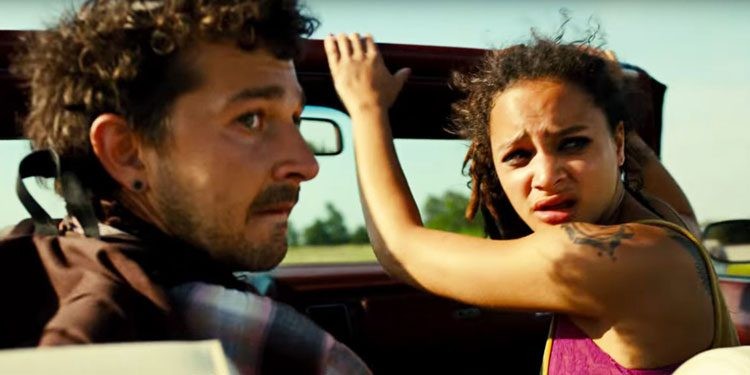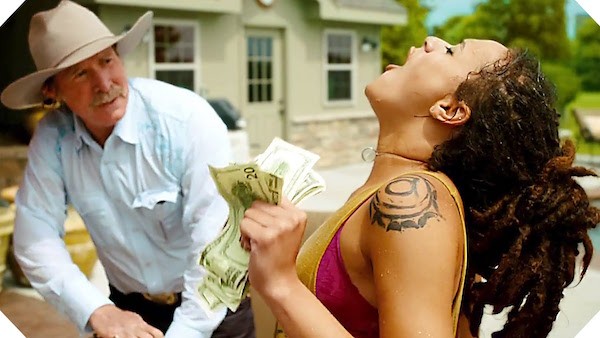American Honey harkens back to a lost era of American filmmaking. Call it the SD DIY period. The mid-1990s saw the advent of high quality digital video cameras that were both cheap enough to be affordable to the average consumer and simple enough to use so that an untrained amateur could, with a relatively modest investment of time, produce a decent image. At the same time, personal computers became powerful enough to handle complex video editing tasks. Suddenly, people all over the world who in times past would have otherwise spent their lives as sideline cinephiles were handed the tools to make their own movies. Punk rock in the 1970s came with the promise that anyone could pick up a guitar and be great, and the DIY filmmakers of 1998-2005 were animated with a similar belief.

Sasha Lane as Star in American Honey
Alongside the new technology was a new philosophy. The Soderbergh/Tarantino/Rodriegez brand of indie film was all about formal experimentation and carrying on a conversation with film history. The Dogme 95 movement of Lars Von Trier and Thomas Vinterberg stressed absolute realism as a way to strip away the damaging meta messaging of capitalist, patriarchal Hollywood filmmaking and empower the voices of the oppressed. Vinterberg’s The Celebration, the first Dogme 95 film, is a real-time account of a family coming to grips with its sexually abusive patriarch. Dogme 95-inspired digital indies gave voices to thousands of filmmakers from marginalized communities, such as LBGT, immigrants, and African Americans. Here in Memphis, Morgan Jon Fox founded the Digital Media Co-Op and created social realist films like Blue Citrus Hearts and OMG/HAHAHA by utilizing confessional Meisner techniques of improvisational acting. Fox’s films of the era looked rough to an audience busy devouring lavish Lord Of The Rings movies, but that was part of the point. The realities people lived in day to day weren’t expertly color corrected, bad guys often weren’t punished, and happy endings could seem few and far between. Look closer at Blue Citrus Hearts, for example, and you’ll find a stunningly sophisticated take on the intimate anxieties of the Bush era.
The American DIY films of this era were created entirely in standard DVD resolution: 720 x 480 pixels, an aspect ratio of 4:3. Roughly, square. Toward the end of the 2000s, cameras and computers graduated to high definition:1920 x 1080 pixels, a rectangular aspect ratio of 16:9. This is the format that your average HD TV uses these days, and it means a much sharper picture with better color resolution that allows for creativity in the image creation that rivals or exceeds traditional 35 MM film. Dogme zeal mutated into mumblecore, becoming less revelatory in the process. Since the films of the SD era don’t match formats with the contemporary video equipment, they are rarely seen today, but you can see one of the best examples of the period online in the form of the remastered version of Craig Brewer’s The Poor And Hungry. Today, the legacy of American DIY’s social realism rests mostly in a style of acting practiced by people like Greta Gerwig, Lena Dunham, and Joe Swanberg.

Shia LaBouf and Sasha Lane
American Honey is infused with nostalgia for the SD DIY era. Even though director Andrea Arnold creates her images with contemporary video equipment, the film is presented in a 4:3 aspect ratio. The actors, including the lead Sasha Lane are all new, raw, and untrained. Well, almost all of them—the two ringers here are bad boy actor Shia LaBeouf and Elvis’ granddaughter Riley Keough.
Lane plays Star, an 18-year-old in an abusive relationship taking care of a pair of kids from her boyfriend’s last marriage. A chance meeting in a Wal-Mart with Jake (LaBouf) gives her a chance to escape her dead end life. Jake runs a “mag crew”, a van load of teenage, semi-homeless misfits who go door to door selling magazine subscriptions. “Who buys magazine subscriptions any more?” Star asks, after she’s already in the van.
“Nobody”, one of her new cohort answers.
The kids on the mag crew are being ruthlessly exploited by Jake and Krystal (Keough), who enforce a cult like order with songs, cheers, and copious drugs. Arnold uses the group dynamics as a critique of late stage capitalism, which reaches its most biting with “losers night”, in which the two lowest earning members of the ragtag team are forced to fight for their bosses’ amusement.
Star is swept along with the mag crew as they prowl the middle of the country, committing petty crimes and having bad sex from Oklahoma to the Bakken shale fracking fields of South Dakota. American Honey is simultaneously a character study of a troubled, poor young woman in the process of slipping through the cracks of American society and a portrait of the decaying heartland seen through her eyes. As a travelogue of cheap motels, it has no parallel.

Arnold creates some indelible scenes along the way, such as when Star gets into a sexually charged situation with three rich men in cowboy hats, and then later when she crosses a final moral line while bathed in the golden light of a natural gas flare. These moments account for the lavish praise the film has received, including the Jury Prize at Cannes. But they are also few and far between. American Honey is a great 90 minute movie crammed into 163 minutes.
In searching for the essence of the SD DIY magic, Arnold has also resurrected, and even amplified, its flaws. Just as punk rock’s promise that everyone has an inner rock star was proven false, so too did hundreds of hours of poorly edited, boring dross spell the end of mumblecore. American Honey seems like the work of a first time filmmaker too in love with her raw material to do the hard emotional work of culling the story down to its essence. I’m not saying that every movie has to be a speedy, plot driven affair. Arnold could have cut fully half of her shots and still retained the episodic structure and ensemble acting dynamics that are clearly her goals here. By the time the film enters its second hour, the goodwill generated by the fresh faced enthusiasm of the actors and flashes of fleeting, accidental beauty is ground down by the editing’s oppressive tedium.
If you want to see this kind of thing done well, check out Morgan Jon Fox’s streaming series Feral, about which I have spilled many pixels. Fox was one of the first to go down the road American Honey follows, and he is an expert on how to carefully pace the delicate dramas and comedies of everyday life. Like its heroine, American Honey is left adrift, aimless, and confused.